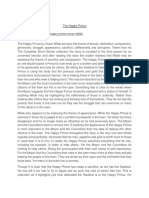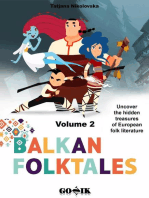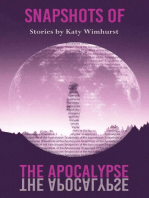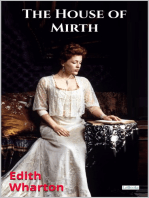0 ratings0% found this document useful (0 votes)
28 viewsEnglish Cia 1
English Cia 1
Uploaded by
dobreprincess lyricsThe story highlights instances of pain and suffering throughout. It depicts a poor seamstress caring for her ill son while embroidering a dress for the Queen's bridesmaid. It also shows a young man struggling to write in the cold without food, and a young girl trying to sell matches to survive. The upper classes ignore the poor and treat them with disrespect, suggesting the futility of their lives in Victorian society, which blamed poverty on personal defects. Specific parts that show Victorian hypocrisy include the seamstress continuing to work while the bridesmaid complains, people ignoring the matchgirl, and the upper classes disregarding the poor children.
Copyright:
© All Rights Reserved
Available Formats
Download as DOCX, PDF, TXT or read online from Scribd
English Cia 1
English Cia 1
Uploaded by
dobreprincess lyrics0 ratings0% found this document useful (0 votes)
28 views3 pagesThe story highlights instances of pain and suffering throughout. It depicts a poor seamstress caring for her ill son while embroidering a dress for the Queen's bridesmaid. It also shows a young man struggling to write in the cold without food, and a young girl trying to sell matches to survive. The upper classes ignore the poor and treat them with disrespect, suggesting the futility of their lives in Victorian society, which blamed poverty on personal defects. Specific parts that show Victorian hypocrisy include the seamstress continuing to work while the bridesmaid complains, people ignoring the matchgirl, and the upper classes disregarding the poor children.
Original Description:
cia
Original Title
ENGLISH CIA 1
Copyright
© © All Rights Reserved
Available Formats
DOCX, PDF, TXT or read online from Scribd
Share this document
Did you find this document useful?
Is this content inappropriate?
The story highlights instances of pain and suffering throughout. It depicts a poor seamstress caring for her ill son while embroidering a dress for the Queen's bridesmaid. It also shows a young man struggling to write in the cold without food, and a young girl trying to sell matches to survive. The upper classes ignore the poor and treat them with disrespect, suggesting the futility of their lives in Victorian society, which blamed poverty on personal defects. Specific parts that show Victorian hypocrisy include the seamstress continuing to work while the bridesmaid complains, people ignoring the matchgirl, and the upper classes disregarding the poor children.
Copyright:
© All Rights Reserved
Available Formats
Download as DOCX, PDF, TXT or read online from Scribd
Download as docx, pdf, or txt
0 ratings0% found this document useful (0 votes)
28 views3 pagesEnglish Cia 1
English Cia 1
Uploaded by
dobreprincess lyricsThe story highlights instances of pain and suffering throughout. It depicts a poor seamstress caring for her ill son while embroidering a dress for the Queen's bridesmaid. It also shows a young man struggling to write in the cold without food, and a young girl trying to sell matches to survive. The upper classes ignore the poor and treat them with disrespect, suggesting the futility of their lives in Victorian society, which blamed poverty on personal defects. Specific parts that show Victorian hypocrisy include the seamstress continuing to work while the bridesmaid complains, people ignoring the matchgirl, and the upper classes disregarding the poor children.
Copyright:
© All Rights Reserved
Available Formats
Download as DOCX, PDF, TXT or read online from Scribd
Download as docx, pdf, or txt
You are on page 1of 3
ENGLISH CIA 1
THE HAPPY PRINCE
1. Spot and highlight the presentation of pain and suffering in the story.
Pain and suffering are shown throughout this story in several different instances. The
happy prince whose statue was stood high and tall right in the center of the town could
see everything far and wide. He would look over the lives of people and weep looking at
those who were suffering in need of some help.
He first mentions a poor house, “far away in a little street” with a woman seated on the
table. She was thin and had a worn-out face with bruises and redness all over her hands
due to the needles she constantly used as a seamstress. She was embroidering flowers
onto a beautiful satin gown for on of the Queen’s bridesmaids. Her ill son slept on a bed
in the corner of the room with a fever and asking his mother for oranges that she could
not afford, due to which he was crying.
The next instant of pain and suffering is shown the next day when the statue talk about a
“young man in a garret” far away across the city. He was leaning over a desk covered
fully with papers and trying to finish a play for the Director of the Theatre. However, he
could not continue writing as he was too cold to do so. The fire is the grate was out and
he had no food to buy himself some food and satisfy his hunger.
The next day, we see an instance of young girl selling matchsticks for a living. She has
dropped all of her matchsticks into the river and she will be unable to sell them. She is
afraid to go back home without any money as she fears her father will beat her. She was
crying and was out in the cold street with no shoes, stockings or hat. This scene can also
be taken as a reference from the story ‘The Little Match Girl’ by author Hans Christian
Anderson.
We see many more instances in the story portraying pain and suffering through the eyes
of the Swallow. The poor were sitting by the gates of the rich in hopes of receiving some
money, clothes or food from them, in the dark, narrow lanes were the “white faces of
starving children” looking out into the streets, under the archway of a bridge were two
boys huddled up into each other trying to keep warm as they fall asleep only to be chased
away into the rain by a rude watchman.
These were all the instances in the short story which highlight the presentation of pain
and suffering that the Prince could not bear to see in his own kingdom which he had once
thought was only filled with happy and satisfied people who had no pain and problems.
2. What in the story is suggestive of futility in life with reference to Victorian
hypocrisy? Can you identify specific parts in the story that highlight the pretentious
nature of Victorian society? List the parts.
Futility in life means a life without any meaning, purpose or value. During the Victorian
Era, the was the state of the poor. Children were made to work from very young ages and
some families would even cast out their children onto the streets if they could not afford
to bring them up. The higher classes Victorians believed that it was their responsibility to
stay out of poverty’s way and blamed any defect in character on the poor.
This exact behavior is seen in the short story ‘The Happy Prince’. At the start, we see a
poor seamstress embroidering flowers onto a satin gown which would be worn by one of
the Queen’s bridesmaids. She is poor and has no money to get rid of her son’s illness or
to buy food. However, she still goes on doing her work to be able to earn some money. In
the meanwhile, the Queen’s bridesmaid who will be wearing the dress walks out of the
church wondering if her dress will be ready on time and calls the poor seamstress a lazy
woman for not finishing the dress faster.
The story also mentions a little matchgirl trying to sell matchsticks to people out on the
cold street but everyone ignores her and goes about their work as if they do not see her. It
is almost like she is non-existent or invisible.
As the Swallow goes around town, he sees several poor, hungry children and looking out
at streets with some hope in them that they will receive help but alas no one pays heed to
them. They are ignored, looked down upon in disgust by the higher class and chased
away from places.
Their lives hold no meaning and the upper class see them as a useless addition to the
society only good for doing their petty work and being their servants. They treat them
with utmost disrespect and do not bother about their well-being one bit.
All this is suggestive of the futility in life that was very clearly seen in the Victorian
society.
We even see the pretentious behavior of the upper class during the Victorian era at the
end of the story when the Mayor and the Town Counsellors were walking past the
withered statue. As soon as they saw that the statue did not have the precious stones and
gold plating on it, they decided that it was worth nothing and brought it down. They
melted the statue in the furnace and threw the heart of the prince in a dust heap where the
dead swallow was also lying.
You might also like
- Grace Doll - Julia Litvin - Workroom Julia LitvinDocument13 pagesGrace Doll - Julia Litvin - Workroom Julia LitvinRdeS90% (10)
- The Sadness CollectorDocument19 pagesThe Sadness Collectorkevindave_gzm60% (5)
- Iyawos Basic RulesDocument4 pagesIyawos Basic Rulesluis_aroche1582100% (4)
- 2Document8 pages2Anonimus BirdsNo ratings yet
- The Happy Prince by Oscar Wilde: 1 B.A. English Part-I Short Stories NotesDocument5 pagesThe Happy Prince by Oscar Wilde: 1 B.A. English Part-I Short Stories NotesTajmmal Mughal100% (1)
- The Happy Princ1Document5 pagesThe Happy Princ1Muhammad ImranNo ratings yet
- Story Critical AnalysisDocument9 pagesStory Critical AnalysisDavid MorganNo ratings yet
- The Happy PrinceDocument10 pagesThe Happy PrincezubairNo ratings yet
- The Happy PrinceDocument17 pagesThe Happy PrinceJavier GuerraNo ratings yet
- BEGE-108 (2012-13) : 1. Write Short Notes On Any TwoDocument9 pagesBEGE-108 (2012-13) : 1. Write Short Notes On Any TwoRajni KumariNo ratings yet
- Thesis For Araby James JoyceDocument5 pagesThesis For Araby James Joycehan0fus1gij2100% (2)
- Teacher's Manual ContentDocument83 pagesTeacher's Manual ContentprathamNo ratings yet
- CC6 Fairy TalesDocument13 pagesCC6 Fairy TalesRitanwita DasguptaNo ratings yet
- Happy Prince SummaryDocument1 pageHappy Prince SummaryRia AthirahNo ratings yet
- Simla Village Tales / Or, Folk Tales from the HimalayasFrom EverandSimla Village Tales / Or, Folk Tales from the HimalayasNo ratings yet
- The American Short Story. A Chronological History: Volume 2 - T S Arthur to Lucy Hamilton HooperFrom EverandThe American Short Story. A Chronological History: Volume 2 - T S Arthur to Lucy Hamilton HooperNo ratings yet
- The Female Short Story. A Chronological History: Volume 9 - Alice Dunbar Nelson to Katherine RickfordFrom EverandThe Female Short Story. A Chronological History: Volume 9 - Alice Dunbar Nelson to Katherine RickfordNo ratings yet
- Dickens's Perception of Female Personality: Representation of Lady Dedlock and Esther Summerson in Bleak HouseDocument5 pagesDickens's Perception of Female Personality: Representation of Lady Dedlock and Esther Summerson in Bleak HouseTanver TopuNo ratings yet
- Charles Dickens and the Street Children of LondonFrom EverandCharles Dickens and the Street Children of LondonRating: 3.5 out of 5 stars3.5/5 (18)
- A Reputed Changeling; Or, Three Seventh Years Two Centuries AgoFrom EverandA Reputed Changeling; Or, Three Seventh Years Two Centuries AgoNo ratings yet
- Unstable Spanish AdministrationDocument6 pagesUnstable Spanish AdministrationGiel Del RosarioNo ratings yet
- The Dolls HouseDocument4 pagesThe Dolls HouseAmelyn Albitos-Ylagan Mote100% (1)
- Symbolism in DickensDocument2 pagesSymbolism in DickensFaisal JahangeerNo ratings yet
- Tale of KieuDocument3 pagesTale of KieuJEMIMAH USARAGANo ratings yet
- Thehappyprince 191101052528Document22 pagesThehappyprince 191101052528Ahmed Ghazi100% (1)
- Laurie Lee-Cider With RosieDocument2 pagesLaurie Lee-Cider With RosieNenad DjukicNo ratings yet
- Financial Accountin CiaDocument2 pagesFinancial Accountin Cia1502picturesNo ratings yet
- Tài liệu ôn tập văn học Anh MỹDocument6 pagesTài liệu ôn tập văn học Anh MỹThanh NhànNo ratings yet
- Learning ActivityDocument9 pagesLearning ActivityJourdanette TarucanNo ratings yet
- Sample Order Confirmation SheetDocument1 pageSample Order Confirmation SheetjasmenNo ratings yet
- Form-8 Uniform Kit List - 23Document5 pagesForm-8 Uniform Kit List - 23kiranstock2No ratings yet
- Unit 4:-Flat Sketches & Specification SheetDocument4 pagesUnit 4:-Flat Sketches & Specification SheetDeepali B MudalgiNo ratings yet
- 6 Meeting Putting The Power Into Your Body Language and Dress CodeDocument10 pages6 Meeting Putting The Power Into Your Body Language and Dress CodeEdward HartantoNo ratings yet
- Spring /summer 2012: October 27 2011Document56 pagesSpring /summer 2012: October 27 2011thewhitecloakNo ratings yet
- ملزمة شاملة انكليزي سادس ابتدائي PDFDocument1 pageملزمة شاملة انكليزي سادس ابتدائي PDFwe weNo ratings yet
- InterludeDocument8 pagesInterludekimNo ratings yet
- BOMBERdotcomJACKET by FridayKnitsDocument11 pagesBOMBERdotcomJACKET by FridayKnitschristineaufdermauerNo ratings yet
- DictionaryDocument91 pagesDictionaryLeslie HooNo ratings yet
- Baby Pato DK CY1001 Baby Romper and Beanie Hat - Newborn To 18 MonthsDocument6 pagesBaby Pato DK CY1001 Baby Romper and Beanie Hat - Newborn To 18 MonthsJac QuilineNo ratings yet
- Irish LiltDocument4 pagesIrish Liltsoniaacio84No ratings yet
- A1 Mid Course Competency Speaking TestDocument3 pagesA1 Mid Course Competency Speaking Testelearning83No ratings yet
- Lead TimeDocument2 pagesLead TimeJyoti RawalNo ratings yet
- BobsBurgers ALDocument55 pagesBobsBurgers ALRuaa AllawiNo ratings yet
- Trimmings and AccessoriesDocument25 pagesTrimmings and AccessoriesHadiuzzaman LeonNo ratings yet
- ActivitiesDocument1,065 pagesActivitiesSandip kumarNo ratings yet
- LMT100 FE PracticeDocument8 pagesLMT100 FE Practicemei chee punNo ratings yet
- DaffodilgnomeDocument9 pagesDaffodilgnomewetolly.crochet100% (1)
- Talisman Performance Ltd. - Corporate Presentation1Document25 pagesTalisman Performance Ltd. - Corporate Presentation1rajeevsera100% (1)
- Lingerie Insight December 2011Document52 pagesLingerie Insight December 2011gab20100% (1)
- 7774 RDVCGJDocument2 pages7774 RDVCGJnornarte creacionesNo ratings yet
- Overridelist and Cheat CodesDocument2 pagesOverridelist and Cheat CodesSpawn 2099No ratings yet
- 16-9-2014Document4 pages16-9-2014MANSA MARKETINGNo ratings yet
- Final Test b1 PDFDocument10 pagesFinal Test b1 PDFAdriana DuránNo ratings yet
- Jamdani SareeDocument10 pagesJamdani SareeTumjid Tuham100% (1)
- Compilation of Non-Existent, Non-Genuine Tax Payers As On 29-02-2024Document565 pagesCompilation of Non-Existent, Non-Genuine Tax Payers As On 29-02-2024try2findmenowNo ratings yet
- INIFD IntroDocument49 pagesINIFD IntroGurleen BhasinNo ratings yet

























































































